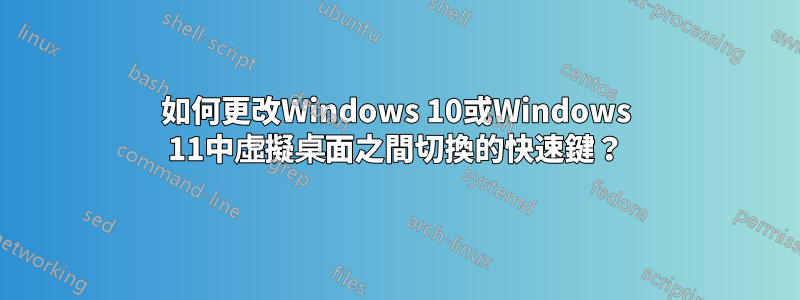
在 Linux 中,我使用快捷方式在 4 個工作區之間切換:win+ 1/2/3/4。
我希望在 Windows 10 或 Windows 11 中擁有類似的功能。
更新解決方案
- (Windows 11 不需要此步驟 - 僅適用於 Window10 使用者)透過此更新您的 Windows 版本到最新版本 更新程式。您可能還需要適用於 Visual Studio 2015 的 Visual C++ 可重複發行元件
- 下載並解壓縮這個Windows 10 虛擬桌面增強器(0.9.1) 對我有用。
- 將文件settings.ini的內容改為
[KeyboardShortcuts] Switch=LWin Move=LAlt, Shift, Ctrl MoveAndSwitch=LAlt, Shift Previous=Left Next=Right PlusTen=
(僅限Windows 11用戶)替換虛擬桌面存取器.dll文件來自https://github.com/skottmckay/VirtualDesktopAccessor/tree/master/x64/Release
跑步虛擬桌面增強器.exe作為行政人員。
使用快捷鍵win+ 1/2/3/n(其中n是您建立的虛擬桌面的數量),可以直接在虛擬桌面之間切換, win+`~可以實現「暴露」效果。
答案1
您需要的內容如下:
- 捕捉視窗: WIN+LEFT或(可與或 一起RIGHT 使用以進入象限)UPDOWN
- 切換到最近的視窗: Alt+ Tab(不變)- 按住顯示新的任務視圖視窗視圖,放開並切換到應用程式。
- 任務檢視: WIN+ Tab– 新任務檢視開啟並保持開啟。
- 建立新的虛擬桌面: WIN+ Ctrl+d
- 關閉目前虛擬桌面: WIN+ Ctrl+F4
- 切換虛擬桌面: WIN+ Ctrl+LEFT或RIGHT
答案2
我想我剛剛構建了您正在尋找的東西。我在 Linux 上使用視窗管理器,並希望在 Windows 上以類似的方式使用熱鍵。
https://github.com/pmb6tz/windows-desktop-switcher
我的腳本使用 CapsLock 因為它對我來說更方便,但您可以輕鬆配置它以適合您。其中可能有一兩個錯誤,但總的來說我發現它非常可靠。希望這可以幫助你!
答案3
我剛剛做了一個腳本自動熱鍵可以在 Windows 10 中為最多 10 個桌面實現此目的。
如何讓它工作:
下載並安裝自動熱鍵。將以下程式碼複製並貼上到記事本中,並使用檔案副檔名 .ahk 儲存
我建議在啟動資料夾中建立此文件的快捷方式,以便它在 Windows 啟動時運行。
預設熱鍵:
切換桌面:WIN+桌上號(0=桌上號10)
新桌面:CTRL+WIN+D
關閉桌面:CTRL+WIN+F4
顯示桌面狀態:WIN+'
重要的:
為了使其工作,您必須僅使用熱鍵來開啟、關閉和變更桌面,因為腳本會偵聽這些熱鍵以了解桌面的當前數量和總數。
如果您確實使用滑鼠透過 WIN+TAB 選單建立、關閉或變更桌面,則腳本將停止運作。為了讓它再次工作,您需要編輯前兩行以反映桌面的當前狀態。 (桌面計數/目前桌面)
這並不意味著您不能使用 WIN+TAB 螢幕作為目前桌面的概覽。實際上,您可以將它與熱鍵結合使用來組織您的桌面。是的,當 Windows 任務檢視器開啟時,熱鍵仍然有效! (WIN+TAB) 只是不要使用滑鼠!
另外,在建立新桌面之前,請等待 Windows 啟動後載入腳本,否則它將無法運作。這可能需要一些時間,具體取決於您有多少啟動程序。
好的,我又添加了一件事,以便更輕鬆地將腳本與桌面狀態重新同步。現在有一個熱鍵可以顯示腳本認為桌面所處的狀態,因此您所要做的就是用滑鼠調整桌面以適應腳本,然後一切都會再次同步!對於使用瑞士鍵盤的我來說,帶有“?”效果很好。 0 旁邊的鍵,有 ? 才有意義但在其他鍵盤上,您可能想要更改此設置,這可以透過將 0/10 熱鍵(以 #' 開頭)後面的行更改為您喜歡的任何內容來輕鬆完成。
實際上,我剛剛意識到......只要桌面計數正確,創建新桌面就會自動重新同步當前桌面值。
(以 ; 開頭的行是註釋,不影響腳本)
代碼:
#NoTrayIcon
;If the script stops working:
;Change the following values to reflect your current desktop state and reload the script.
;Remember to change them back to 1 after reloading the script if you have it set to start with Windows
desktopcount := 1
currentdesktop := 1
;You can change the hotkeys for creating, closing, and switching desktops bellow.
;The current hotkeys are CTRL+WIN+D for new desktop, CTRL+WIN+F4 to close desktop
;and WIN+NUMBER for switching desktops.
;For example, to change the hotkey for new desktop replace ^#D bellow with the desired hotkey.
;Refer to the autohotkey documentation for a full list of symbols refering to modifier keys,
;as you can see ^ is CTRL and # is WIN key.
;If you wanted to change the switch desktop from WIN key to CTRL for example you would have
;to replace the # before each number to a ^
^#D::NewDesktop()
^#F4::CloseDesktop()
#1::SwitchDesktop(1)
#2::SwitchDesktop(2)
#3::SwitchDesktop(3)
#4::SwitchDesktop(4)
#5::SwitchDesktop(5)
#6::SwitchDesktop(6)
#7::SwitchDesktop(7)
#8::SwitchDesktop(8)
#9::SwitchDesktop(9)
#0::SwitchDesktop(10)
#'::MsgBox Desktop Count = %desktopcount%`nCurrent Desktop = %currentdesktop%
;Do not change anything after this line, unless you know what you are doing ;)
;-----------------------------------------------------------------------------------------------
SwitchDesktop(desktop)
{
global desktopcount
global currentdesktop
desktopdiff := desktop - currentdesktop
if (desktop > desktopcount)
{
return
}
if (desktopdiff < 0)
{
desktopdiff *= -1
Loop %desktopdiff%
{
Send ^#{Left}
}
}
else if (desktopdiff > 0)
{
Loop %desktopdiff%
{
Send ^#{Right}
}
}
currentdesktop := desktop
}
NewDesktop()
{
global desktopcount
global currentdesktop
if (desktopcount > 9)
{
return
}
desktopcount ++
currentdesktop := desktopcount
Send ^#d
}
CloseDesktop()
{
global desktopcount
global currentdesktop
desktopcount --
if (currentdesktop != 1)
{
currentdesktop --
}
Send ^#{f4}
}
答案4
例如,我想為下一個桌面設定 Page Down,為上一個桌面設定 Page Up 在我安裝 AutoHotkey 後,我建立一個新的 AutoHotKey 腳本並向其中新增此程式碼並儲存,然後執行腳本
PgDn::^#Right ;Next Desktop
return
PgUp::^#Left ;Previous Desktop
return
效果會很好:)
更新:有時上面的程式碼不起作用,您必須單擊某個點。
PgDn::
{
MouseGetPos,,,win
WinGetClass, class, ahk_id %win%
If class in Progman,WorkerW
send {Click}^#{Right}
else
send ^#{Right} ; Next Desktop
return
}
PgUp::
{
MouseGetPos,,,win
WinGetClass, class, ahk_id %win%
If class in Progman,WorkerW
send {Click}^#{Left}
else
send ^#{Left} ; Previous Desktop
return
}


